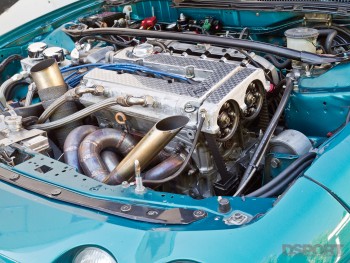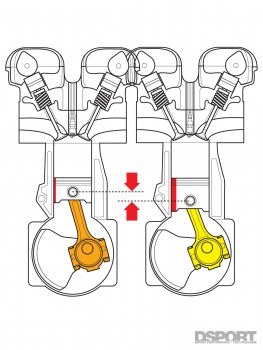RECIPE FOR POWER
 Anybody with knowledge about Honda engines knows that aiming for greater power levels will only lead to expensive holes if the appropriate measures aren’t taken. Increasing the power output of the GS-R’s native B18C1 engine began on the inside. Somers Auto Machine fitted the block with ductile-iron cylinder liners from Golden Eagle before increasing the bores by 3mm over stock. Then, the 84mm bores were filled with 10.5:1 compression Wiseco pistons that make the connection to the stock crankshaft by way of Manley Turbo Tuff rods. To improve the volumetric efficiency of the engine, English Racing ported the cylinder head and upgraded the valvetrain with Ferrea Comp Plus Valves and shimmed Supertech valve springs. Once the longblock was assembled with ARP head studs, it displaced 1,933cc and could spin to 10,000 rpm. To remedy his oil starvation issue, Kerr added a Moroso aluminum oil pan that increased the oil capacity by an extra quart and features baffles to trap oil around the pickup.
Anybody with knowledge about Honda engines knows that aiming for greater power levels will only lead to expensive holes if the appropriate measures aren’t taken. Increasing the power output of the GS-R’s native B18C1 engine began on the inside. Somers Auto Machine fitted the block with ductile-iron cylinder liners from Golden Eagle before increasing the bores by 3mm over stock. Then, the 84mm bores were filled with 10.5:1 compression Wiseco pistons that make the connection to the stock crankshaft by way of Manley Turbo Tuff rods. To improve the volumetric efficiency of the engine, English Racing ported the cylinder head and upgraded the valvetrain with Ferrea Comp Plus Valves and shimmed Supertech valve springs. Once the longblock was assembled with ARP head studs, it displaced 1,933cc and could spin to 10,000 rpm. To remedy his oil starvation issue, Kerr added a Moroso aluminum oil pan that increased the oil capacity by an extra quart and features baffles to trap oil around the pickup.
Kerr elected to retain the Extreme Turbo Systems turbo kit, which centers on an ETS manifold and a Precision Turbo 6262 turbocharger. At the time this set up had not yet been tested to its fullest capacity, and he felt more could be had from the system. When English Racing was tuning the Hondata V3 S300 ECU, they noticed the higher boost levels were blowing out the spark and causing incomplete combustion. He sourced a viable solution from T1 Race Development. The T1/M&W Pro 10 ignition system improved the spark energy being delivered and permitted tuning at higher boost levels. With the tables adjusted accordingly, the Integra generated 742 horsepower and 467 lb-ft of torque to the wheels.
STREET CAR, LOOSELY DEFINED
 Kerr wasn’t just aiming for 190 mph. He wanted to do it in something that still resembled a street car. Inside, most of the GS-R’s interior had been retained, including its original seats, albeit ones now enshrouded inside of a five-point roll cage and with GForce harnesses strapped about them. It’s insured. It’s registered. And as far as the state of Washington’s emissions testing standards are concerned, it passes muster. Kerr will tell you it’s a streetcar but without the wink and the nod that you’d expect. He drives it every weekend, accumulating at least 500 miles of abuse every month. Hondata’s S300 engine management system and traction control allow Kerr to tailor boost pressure to all five gears. The results are decreased boost and torque distribution in lower gears where traction’s harder to come by and the full 31psi at higher vehicle speeds.
Kerr wasn’t just aiming for 190 mph. He wanted to do it in something that still resembled a street car. Inside, most of the GS-R’s interior had been retained, including its original seats, albeit ones now enshrouded inside of a five-point roll cage and with GForce harnesses strapped about them. It’s insured. It’s registered. And as far as the state of Washington’s emissions testing standards are concerned, it passes muster. Kerr will tell you it’s a streetcar but without the wink and the nod that you’d expect. He drives it every weekend, accumulating at least 500 miles of abuse every month. Hondata’s S300 engine management system and traction control allow Kerr to tailor boost pressure to all five gears. The results are decreased boost and torque distribution in lower gears where traction’s harder to come by and the full 31psi at higher vehicle speeds.



